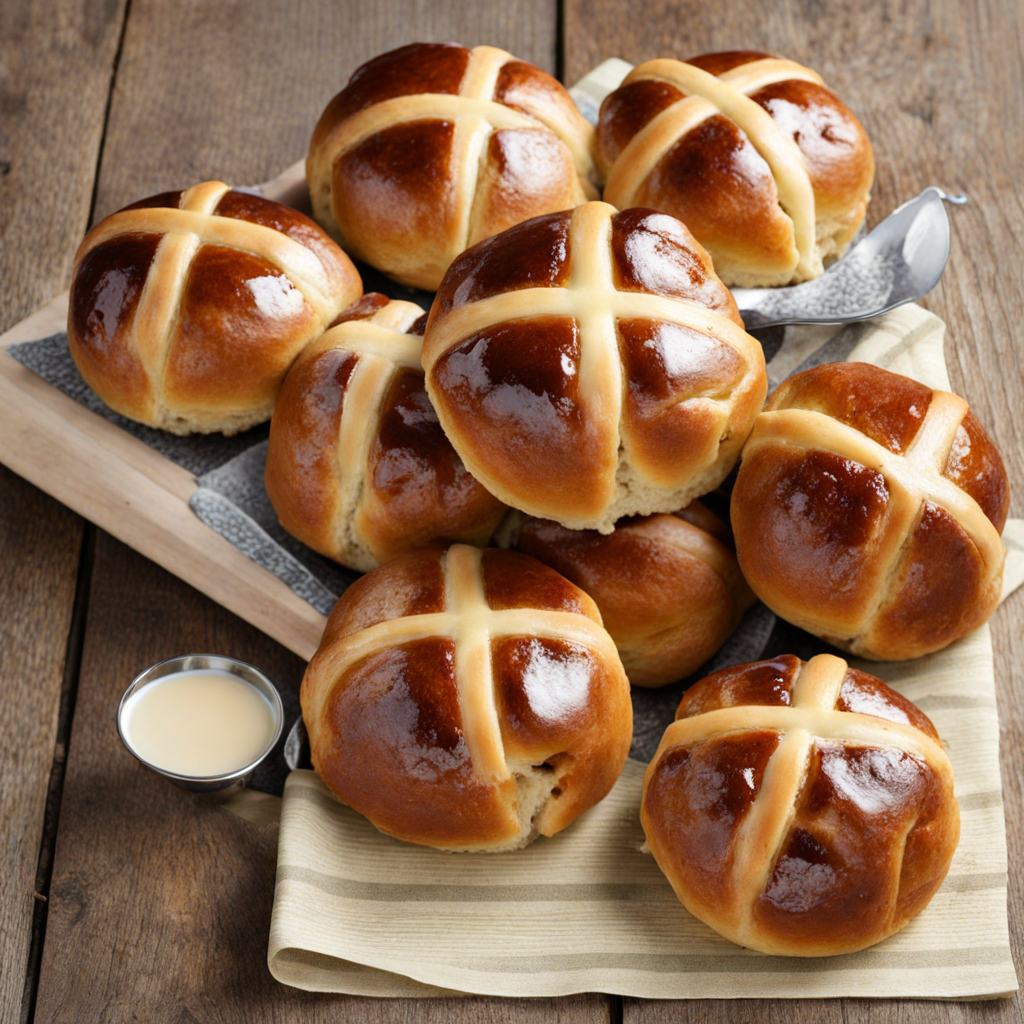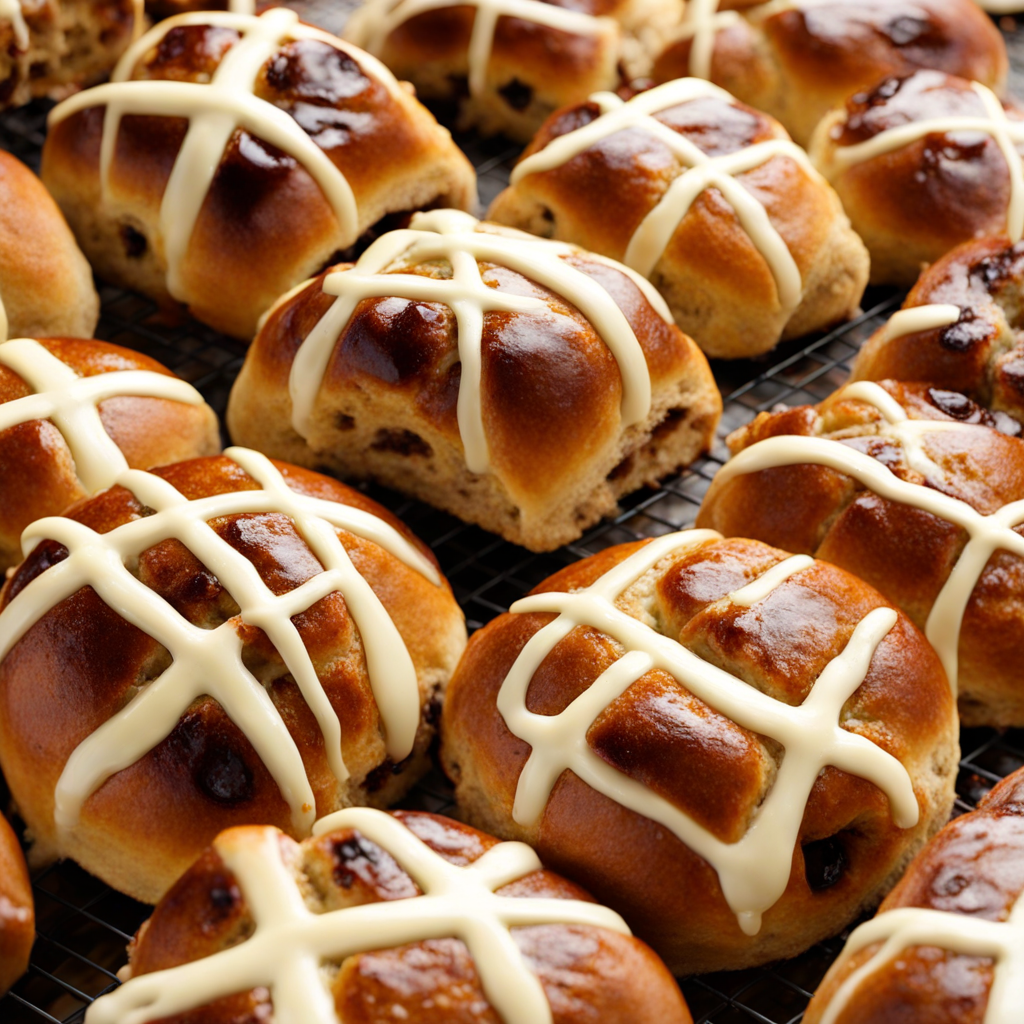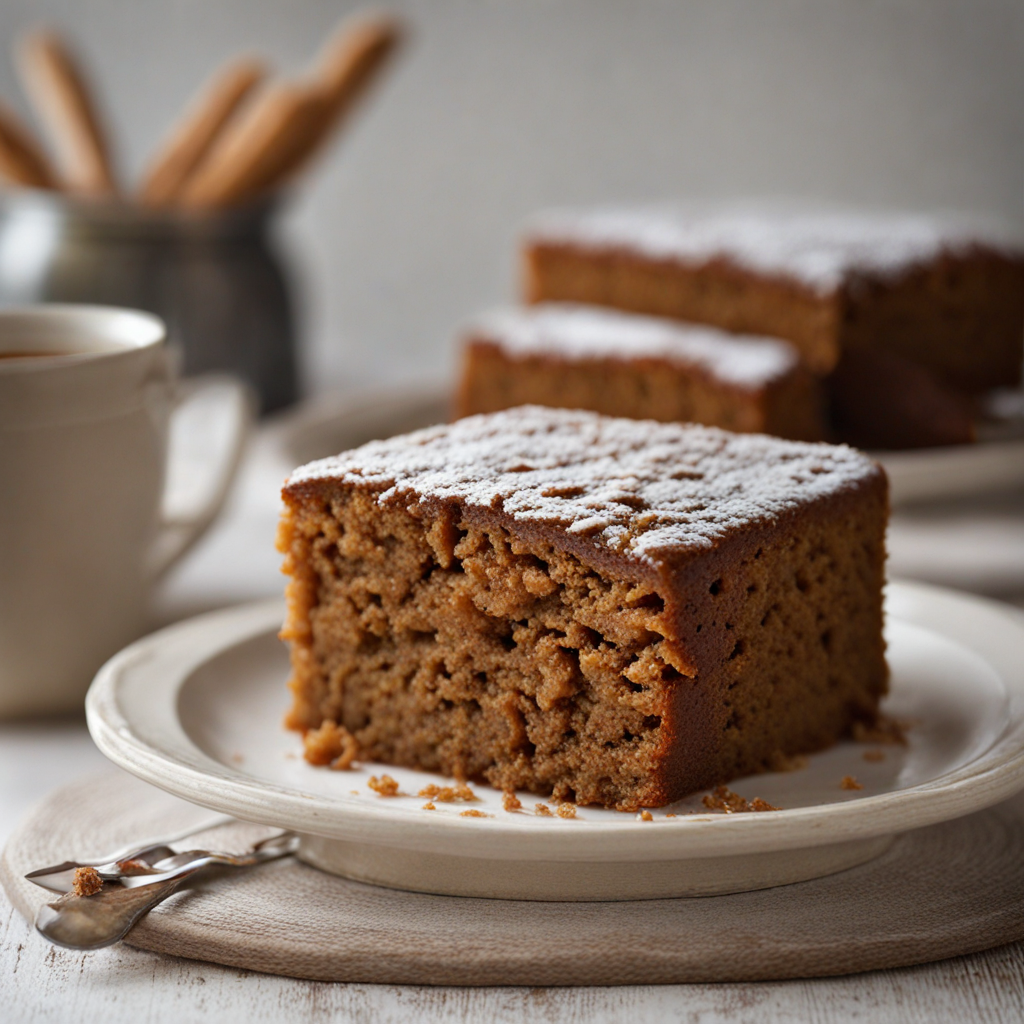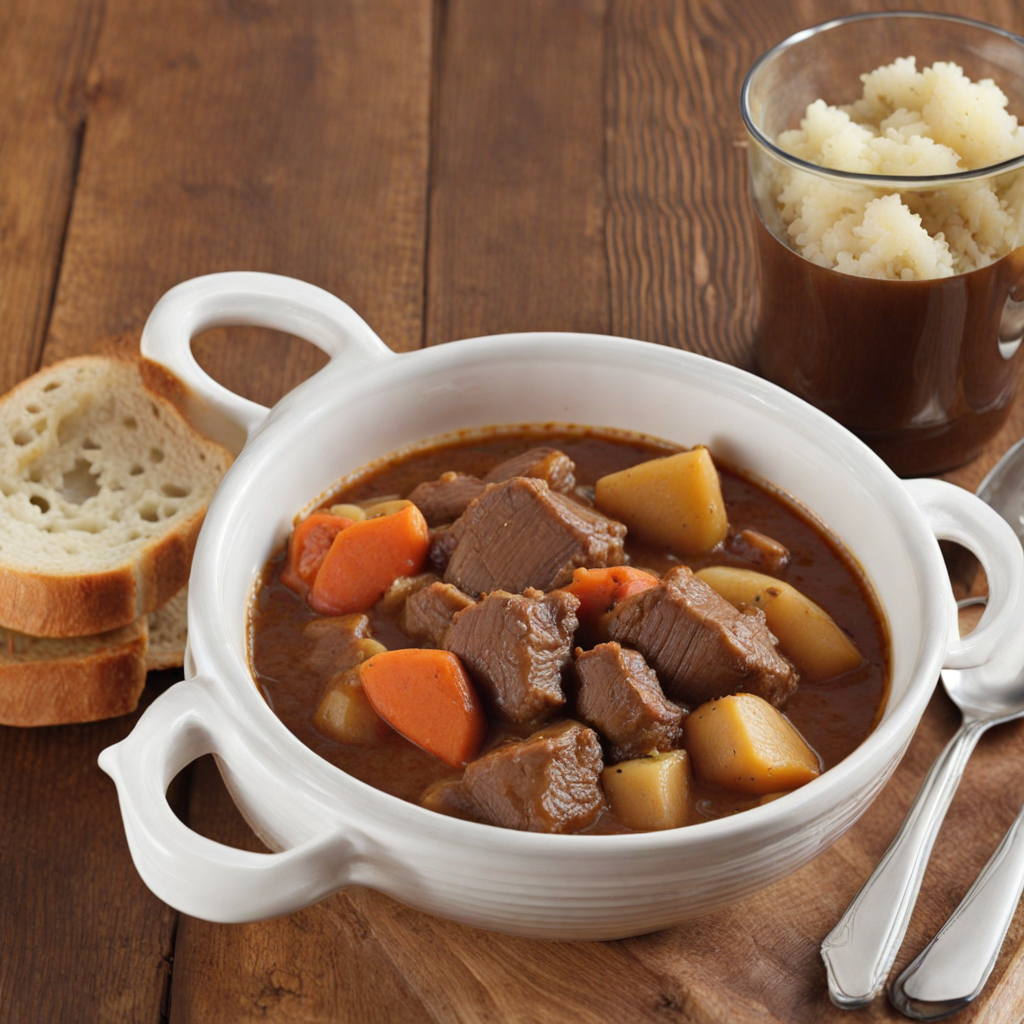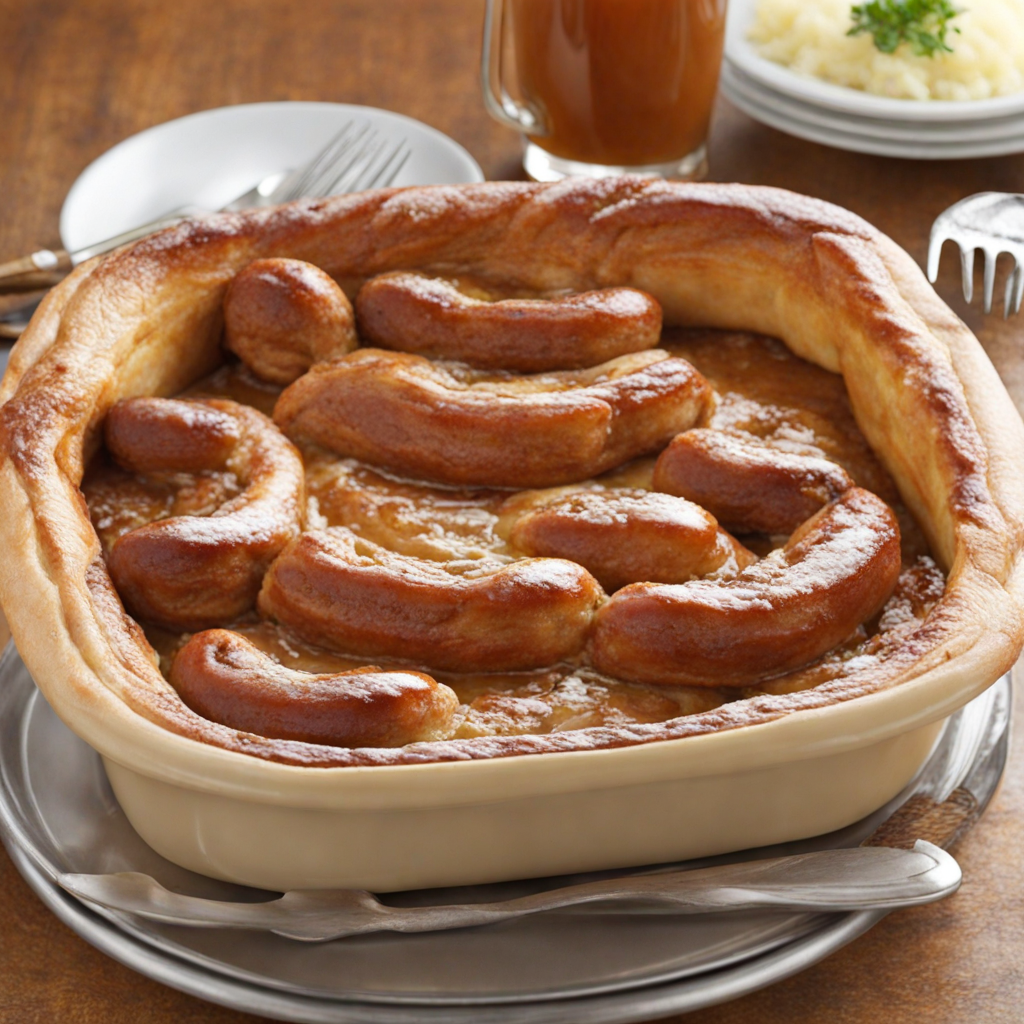Hot Cross Buns
Hot Cross Buns are a delightful spiced sweet bun that hails from the United Kingdom, traditionally associated with Good Friday and the Easter season. These soft, pillowy buns are enriched with a combination of currants or raisins, which add bursts of natural sweetness and a chewy texture. The dough is typically flavored with warm spices such as cinnamon, nutmeg, and allspice, giving each bite a comforting, aromatic quality that evokes the essence of home baking. The hallmark of a Hot Cross Bun is the distinctive cross that adorns the top, which is made from a simple paste of flour and water or a sugar glaze. This symbol has deep-rooted significance, representing the crucifixion of Jesus, which is why they are often enjoyed during the Lenten season. Once baked, the buns are typically brushed with a sweet syrup or glaze to give them a shiny finish, enhancing their visual appeal and adding a touch of sweetness that complements the spiced bread perfectly. When it comes to enjoying Hot Cross Buns, they are best served warm, often toasted with a pat of butter melting into the soft, fluffy center. The combination of the sweet, spiced flavor and the rich, buttery texture makes for an indulgent treat that pairs wonderfully with a cup of tea or coffee. Whether enjoyed as a breakfast item, a snack, or a dessert, Hot Cross Buns provide a unique and delightful taste experience that captures the essence of British culinary tradition.
How It Became This Dish
The History of Hot Cross Buns #### Origin and Early History Hot cross buns are a beloved sweet, spiced bun traditionally eaten in the United Kingdom, particularly around Easter. The origins of hot cross buns can be traced back to ancient times, with roots embedded deeply in both pagan and Christian traditions. The name "hot cross bun" itself refers to the cross that adorns the top of the bun, symbolizing the crucifixion of Jesus Christ. The earliest records of buns resembling hot cross buns date back to the 12th century. In 1361, there is mention of a spiced bun made by an English monk, who is said to have baked them for the poor on Good Friday. This early version was not necessarily sweet and may have been more akin to the rustic bread of the time. The introduction of spices like cinnamon and nutmeg into the dough likely came from the Middle Eastern trade routes, reflecting the culinary exchanges that were becoming increasingly prominent in Europe. By the 16th century, the popularity of these buns began to grow, especially in London. They were sold by street vendors and became associated with various festivals and celebrations. The cross on the bun, originally symbolic of the Christian faith, also had ties to pagan rituals, marking the end of winter and the arrival of spring. #### Cultural Significance Hot cross buns hold significant cultural importance in British society, particularly during Lent and Easter. The cross is a powerful Christian symbol, representing sacrifice and redemption. Traditionally, hot cross buns were made on Good Friday and eaten on Easter Sunday, marking the end of Lent, a period of fasting and reflection leading up to Easter. In addition to their religious connotations, hot cross buns have also been intertwined with various superstitions and folklore. For instance, it was believed that hanging a hot cross bun in the kitchen would protect the house from evil spirits and ensure that all baked goods would rise perfectly. Some also believed that sharing a bun with someone would cement a friendship. The buns were thought to have medicinal properties, and many believed they could cure ailments or bring good fortune. Another interesting tradition surrounding hot cross buns is the significance of their ingredients. The use of currants and sultanas was not just for flavor; these dried fruits held connotations of prosperity and good health. In the 18th century, the buns became a symbol of community and sharing, often baked in larger quantities to be distributed among neighbors. #### Development Over Time As the popularity of hot cross buns grew, so did their variations. By the 18th century, the buns began to reflect regional differences in the United Kingdom. Some versions incorporated richer ingredients, such as butter or milk, while others maintained a more austere recipe, reflecting the frugality of the times. The introduction of sugar in the 19th century transformed hot cross buns from a simple bread into a sweeter, more decadent treat. The Victorian era saw an explosion in the popularity of hot cross buns, with bakeries and shops across Britain producing them in large quantities. The buns became not only a religious symbol but also a commercial product, with advertisements promoting their availability around Easter. This commercialism led to a shift in how they were perceived, moving from a homemade tradition to a store-bought indulgence. The 20th century saw further evolution, with the advent of mass production and the rise of supermarkets. Hot cross buns became nearly ubiquitous in the weeks leading up to Easter, available in a multitude of flavors and styles, including chocolate chip, caramel, and even gluten-free versions. The traditional recipe, however, remains cherished by many, with families often holding onto secret recipes passed down through generations. Hot cross buns also became a symbol of British identity, particularly during World War II. The buns were rationed, and their scarcity made them more desirable, leading to a nostalgic yearning for the traditional flavors of home. After the war, the recipe began to flourish again, with bakers experimenting with new ingredients and techniques, further diversifying the bun's appeal. #### Modern-Day Significance Today, hot cross buns have transcended their religious origins and are enjoyed by people of all backgrounds. They are celebrated not only in the UK but also in countries with British colonial ties, including Australia, New Zealand, and South Africa. Each region has developed its own unique take on the classic recipe, incorporating local flavors and preferences. In recent years, there has been a resurgence of interest in artisanal baking, leading many to return to the traditional methods of making hot cross buns. Home bakers experiment with recipes, using organic ingredients and focusing on the craft of baking. The trend towards sustainability and local sourcing has also influenced how hot cross buns are made and consumed. Nonetheless, the buns remain a staple of the Easter season, often served fresh out of the oven, toasted, and slathered with butter. The delight of breaking apart a warm bun, revealing its fragrant spices and rich fruit, continues to evoke a sense of comfort and nostalgia. #### Conclusion Hot cross buns are more than just a seasonal treat; they are a tapestry of history, culture, and community. From their ancient origins to their modern-day iterations, they represent a unique blend of religious significance, cultural tradition, and culinary evolution. As they are enjoyed across the globe, hot cross buns serve as a delicious reminder of the interconnectedness of food and culture, transcending the boundaries of time and tradition. Whether enjoyed with family on Easter Sunday or savored as a simple pleasure throughout the season, hot cross buns remain a cherished part of the British culinary landscape, embodying the flavors and stories of generations past.
You may like
Discover local flavors from United Kingdom


